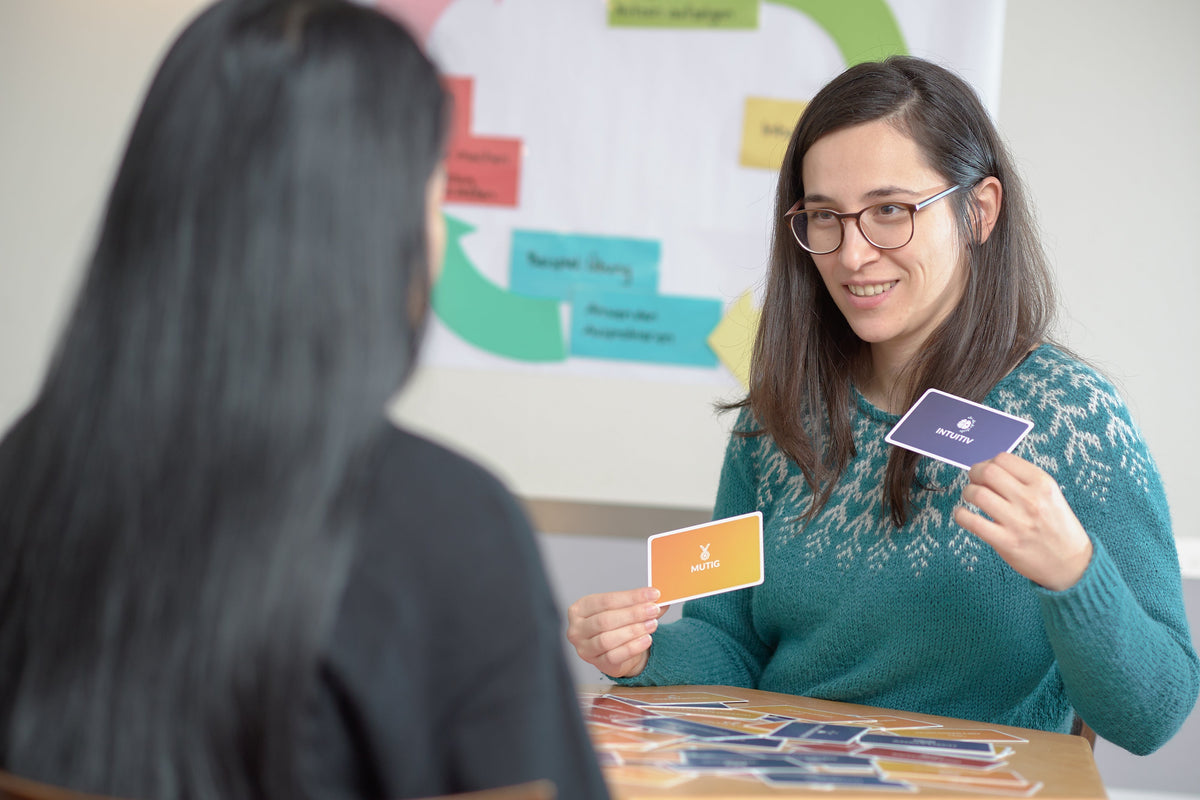

Artikel Inhalt
Ein positives und wertschätzendes Teamumfeld ist für eine erfolgreiche Zusammenarbeit und Produktivität unerlässlich. Eine der besten Möglichkeiten, dies zu erreichen, ist die Anerkennung und das Feiern von Einzelperson Stärken.
Die Moderation von Gruppenarbeit kann jedoch eine Herausforderung sein, wenn es darum geht, alle Beteiligten bei der Stange zu halten und gleichzeitig Beziehungen innerhalb der Gruppe aufzubauen, d.h. psychologische Sicherheit zu schaffen. Um dir bei dieser Herausforderung zu helfen, wird in diesem Blogbeitrag untersucht, wie die Methode "Die Stärken, die ich in dir sehe" und die Verwendung von Coaching-Karten ein großartiges Werkzeug sein kann, um deine Teilnehmer/innen dazu zu inspirieren, sich ihrer Stärken bewusst zu werden, sie zu teilen und zu schätzen.
Die Vorteile von Stärkenkarten
Stärkenkarten können in verschiedenen Kontexten eingesetzt werden, z. B. bei Teamentwicklungsprogrammen, Klausuren oder Retrospektiven. Diese Aktivität bietet den Teammitgliedern die Möglichkeit, sich zu vernetzen, die Stärken der anderen zu schätzen und wertvolle Feedbackgespräche zu führen.
Mit solchen Aktivitäten kannst du den Teammitgliedern die Möglichkeit geben, miteinander in Kontakt zu treten, die Fähigkeiten der anderen anzuerkennen und einen stärkeren Sinn für Teamarbeit zu entwickeln, der zu mehr Produktivität und Erfolg führt.
Verwendung von Stärkenkarten für Vor-Ort- und virtuelle Sitzungen
Vor Ort
- Verwenden Sie einen Satz Postkarten, gedruckte hochwertige Bilder von Websites wie Unsplashoder das kuratierte Kartenset "Deine Stärken" von metaFox.eu.
- Wenn du mit einer größeren Gruppe arbeitest, bilde kleinere Gruppen von 4 bis 8 Teilnehmern, damit alle genug Zeit haben, sich zu beteiligen und zu interagieren. Jede Gruppe sollte ein eigenes Kartenspiel mit ihren Stärken haben.
Virtuell
- Wähle aus einer großen Auswahl an kostenlosen und herunterladbaren Bildern von Unsplash um deine digitalen Stärkenkarten zu erstellen. Du kannst Online-Plattformen nutzen wie Conceptboard, Miro, Wandmalerei um die ausgewählten Stärkekarten zusammenzustellen. Alternativ kannst du auch icebreaker.online, a metaFox Coaching-Tool für die Browser-Anwendung.
- Richte virtuelle Gruppenräume mit 3 bis 5 Personen ein, je nachdem, wie viel Zeit zur Verfügung steht. Gib jeder Gruppe einen separaten Link, um auf die digitalen Stärkekarten zuzugreifen.
Zeitplanung
Das Timing ist entscheidend. Deshalb schätzen wir es für dich! Für die folgenden beschreibenden Schritte musst du zusätzlich Zeit einplanen. Achte darauf, dass du dich an die Zeitvorgaben hältst und sage deinen Teilnehmern immer im Voraus, wie viel Zeit sie für jeden Schritt haben. Das hilft dabei, die Erwartungen zu steuern und die bestmöglichen Ergebnisse zu erzielen.

Moderation der Aktivität
Teilt die Gruppe in Untergruppen ein
Teilt die Gruppe in Untergruppen von 3-5 Personen auf, die jeweils ein eigenes Kartenset erhalten. So wird sichergestellt, dass alle Teilnehmer/innen genügend Karten zur Auswahl haben.
Bei einer Gruppe von 5 Personen verwendest du 5 x 4 = 20 Karten aus dem Satz von 52. Damit bleibt genügend Auswahl für alle Teilnehmer/innen der Übung. Es ist möglich, mehr Teilnehmer/innen einzubeziehen, aber es besteht die Gefahr, dass jemand nicht "die Karte findet, die er/sie sucht".
Je nachdem, was du vorhast, kannst du die Leute nach dem Zufallsprinzip, nach gemeinsamen Interessen oder danach gruppieren, wie gut sie sich bereits kennen. Platziere die Leute in der gleichen Kleingruppe die du starke Beziehungen zueinander aufbauen willst.
Tipps:
- Wenn es mehrere Personen gibt, die die Untergruppen moderieren können, ist das perfekt. Wenn nicht, erstelle eine kurze Version dieses Leitfadens und übergebe ihn an eine bestimmte Person pro Kleingruppe.
- Wenn du mit mehreren Untergruppen arbeitest, aber die einzige Person bist Moderator stelle sicher, dass du die Räume vor der Übung vorbereitest. Das erleichtert die Arbeit und macht die Übung sehr professionell.
Lege die Bildkarten vor die Kleingruppe
Dieser Schritt wird dazu beitragen, positive Gedanken übereinander zu entdecken, die vielleicht unbemerkt geblieben sind. Lege die Karten auf einem Tisch oder auf dem Boden aus und zeige die Bildseite der Karten vor der Gruppe.
- Bei Sitzungen vor Ort legst du die Bildkarten mit der Bildseite nach oben vor die Gruppe.
- Für virtuelle Sitzungen wählst du ein Bild oder eine Stärke Kartenset von icebreaker.online oder teile den Einladungslink zum Kartenset den du in einer anderen Online-Anwendung erstellt hast, mit den Teilnehmern.
Variante: Du kannst dich dafür entscheiden, die Kartenseite mit den Kraftworten zu verwenden. In diesem Fall werden die Menschen eher aus einer kognitiven als aus einer emotionalen Perspektive arbeiten. Worte sprechen unseren Verstand an, während Bilder unser Herz ansprechen. Es hängt von deinen Teilnehmern ab, was für sie am besten funktioniert.
Verwende Leitfragen, um den Teilnehmern bei der Reflexion und Auswahl zu helfen
Frag alle reflektieren nach ihrer Zusammenarbeit mit den anderen Teilnehmern. Verwende Leitfragen, um die richtigen Bilder zu finden in man Reflexion zu helfen, während du alle bittest, ein Bild für jede andere Person zu wählen.
Hier sind einige offene Leitfragen, die du verwenden kannst:
"Welche Stärken siehst du bei deinen Teamkollegen?" "Wie nehmt ihr die Stärken der anderen in dieser Gruppe wahr? "Welche Stärken, die du bewunderst, siehst du bei deinen Teamkollegen?" "Welche versteckten Stärken gibt es in dieser Gruppe, die noch besser genutzt werden könnten?" "Was sind die besonderen Stärken in dieser Gruppe, die zu einer positiven und kooperativen Teamkultur beitragen?
Du siehst, dass die Beispielfragen unterschiedliche Schwerpunkte setzen, entweder Einzelperson Stärken oder Gruppenstärken. Wähle die Formulierung und den Schwerpunkt, der am besten zu deiner Intention der Übung passt.
Nimm dir ausreichend Zeit, um die Karten auszuwählen und darüber nachzudenken.
Eine Schritt-für-Schritt-Videoanleitung, wie man Einzelperson Stärken in einem Team erkennt.
Individuelle Reflexion
Wenn alle Karten verteilt sind, lass die Teilnehmer zu ihren Stühlen zurückgehen und gib ihnen etwas Zeit reflektieren. Ermutige alle dazu, auf die Rückseite der Karte zu schreiben, welche Kraft sie mit dem Bild verbinden. Was wollte die andere Person mit der Übergabe dieses Bildes sagen? Wenn du es aufschreibst, fällt es dir leichter, im nächsten Schritt das Selbstbild mit dem öffentlichen Bild zu verbinden.
Sharing is Caring: Selbstbild und öffentliches Bild
In den Untergruppen teilt jede/r Teilnehmer/in zunächst mit, was sie/er über die Karten denkt und was sie/er glaubt, dass die Absicht hinter der jeweiligen Karte war. Danach kann die Person, die die Karte gegeben hat, sagen, was ihre eigentliche Absicht war und mit welcher Stärke sie das Bild verbunden hat. Du kannst das Gespräch mit Fragen wie "Welches Verhalten verbindest du mit dieser Stärke?", "Wie drückt sie diese Stärke aus?" oder "Wie trägt diese Stärke zum Erfolg unseres Teams bei?" weiterführen. Bitte die Teilnehmer/innen, das, was sie hören, auch auf der Rückseite der Karten aufzuschreiben. Jetzt haben sie ihre eigene Interpretation und die Interpretation des Teams.
Tipps:
- Wähle die erste Person aus, die als effektives Vorbild dienen kann, teile ihre gewählte Karte mit und erkläre, warum sie sie gewählt hat.
- Um das Engagement aufrechtzuerhalten, teilen die Teilnehmenden ihre gewählten Karten in einer bestimmten Reihenfolge, bis alle geteilt haben.
Nachbesprechung in der gesamten Gruppe
Bringe alle Untergruppen wieder in der Gesamtgruppe zusammen und führe die Nachbesprechung der Übung durch, indem du die verschiedenen Phasen der Nachbesprechung anhand von Leitfragen durchgehst. Natürlich funktioniert die Nachbesprechung nicht nach einer rein linearen Logik.
Diese 4 Phasen zeigen, wie wir von der Diskussion der unmittelbaren Erfahrung über die Abstraktion bis hin zum Bezug auf zukünftige Absichten und Verhaltensänderungen kommen:
- Gefühle: Wie geht es dir? Wie hast du die Übung erlebt?
- Fakten: Was ist passiert? Was hast du getan?
- Feststellungen: Was hast du bei der Übung gelernt? Über dich selbst? Über die anderen Teilnehmer?
- Zukunft: Wie wirst du dieses Wissen in Zukunft nutzen? Was wirst du morgen anders machen?
Verbessere deine Team-Moderation mit metaFox Coaching-Tools
Die Stärken liegen darin, ein Umfeld zu schaffen, das Wertschätzung, Feedback und Selbstwahrnehmung innerhalb eines Teams oder einer Gruppe. Durch den Einsatz von Stärkenkarten und die Moderation von Aktivitäten, die zum Mitmachen anregen, kannst du ein Umfeld schaffen, in dem die Teammitglieder miteinander in Kontakt treten, die Stärken der anderen schätzen und Feedbackgespräche führen können.
Bist du bereit, deine Teammoderation zu verbessern? Besuche metaFox.eu noch heute unsere verschiedenen Kartensets und entdecke die unendlichen Möglichkeiten für Teamentwicklung und Zusammenarbeit.



